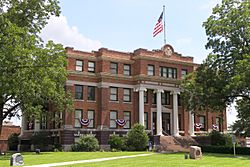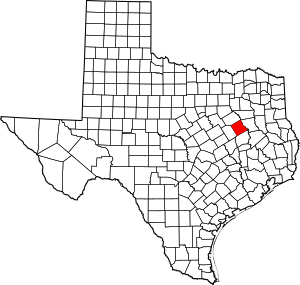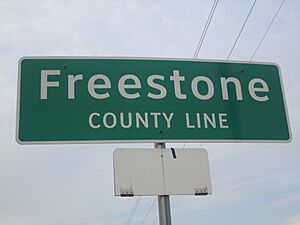Freestone County, Texas facts for kids
Quick facts for kids
Freestone County
|
|
|---|---|

The Freestone County Courthouse in Fairfield
|
|

Location within the U.S. state of Texas
|
|
 Texas's location within the U.S. |
|
| Country | |
| State | |
| Founded | 1851 |
| Seat | Fairfield |
| Largest city | Teague |
| Area | |
| • Total | 892 sq mi (2,310 km2) |
| • Land | 878 sq mi (2,270 km2) |
| • Water | 14 sq mi (40 km2) 1.6% |
| Population
(2020)
|
|
| • Total | 19,435 |
| • Density | 21.788/sq mi (8.412/km2) |
| Time zone | UTC−6 (Central) |
| • Summer (DST) | UTC−5 (CDT) |
| Congressional districts | 6th, 17th |
Freestone County is a county in the east-central part of Texas, a state in the United States. As of the 2020 census, about 19,435 people lived there. Its main town, or county seat, is Fairfield. The county was officially created in 1850 and started operating in 1851.
Contents
History
Native American Tribes
Long ago, around 200 BCE, the Kichai people lived in the Freestone County area. They were farmers and part of the Caddoan Mississippian culture. In 1541, the Hernando de Soto expedition had some difficult encounters with them.
Later, Spanish and French missionaries arrived. They brought diseases like smallpox and measles. The Caddo people had no protection against these illnesses. Sadly, many Caddo were forced to move to special areas called reservations.
The Tawakoni tribe, a branch of the Wichita people, also lived in East Texas. From 1843, the Tawakoni were part of agreements with both the Republic of Texas and the United States.
How the County Was Formed
In 1826, a person named David G. Burnet received permission from the government to bring 300 families to settle here. The government wanted to control how new areas were settled.
For a while, people were afraid to settle in Freestone County because of possible conflicts with Native Americans. But after the Treaty of Bird's Fort, more settlers arrived. Most of these new families came from Southern states. By 1850, so many people had moved to the area that the Texas government created Freestone County.
The name "Freestone" describes the good quality of the soil. The county officially began in 1851, and Fairfield became its county seat. In 1860, more than half of the county's 6,881 residents were enslaved people.
When the American Civil War began, Freestone County voted strongly to leave the Union. After the war, during a time called Reconstruction, the number of farms in the county actually doubled.
In the 1870s, new railroads were built near the county. This helped the local economy grow. Another railroad, the Trinity and Brazos Valley Railway, crossed the county in 1906, boosting the economy even more.
During the 1920s and early 1930s, the sale of alcohol was against the law in the U.S. This time was called Prohibition. Some people in Freestone County made and sold alcohol illegally, which was called "bootlegging." This helped them earn money when times were tough.
In 1969, a power plant was built near Fairfield. This created many jobs for people in the county. A dam was also built to create Fairfield Lake. This lake helps cool the power plant. In 1972, Fairfield Lake State Park opened, offering a place for people to enjoy nature.
Geography
Freestone County covers about 892 square miles. Most of this area, about 878 square miles, is land. The remaining 14 square miles, or 1.6%, is water.
Major Highways
 Interstate 45
Interstate 45 U.S. Highway 79
U.S. Highway 79 U.S. Highway 84
U.S. Highway 84 U.S. Highway 287
U.S. Highway 287 Texas State Highway 14
Texas State Highway 14 Texas State Highway 75
Texas State Highway 75 Texas State Highway 164
Texas State Highway 164 Texas State Highway 179
Texas State Highway 179
Neighboring Counties
Freestone County shares borders with these other counties:
- Henderson County (north)
- Anderson County (northeast)
- Leon County (southeast)
- Limestone County (southwest)
- Navarro County (northwest)
Population Information
| Historical population | |||
|---|---|---|---|
| Census | Pop. | %± | |
| 1860 | 6,881 | — | |
| 1870 | 8,139 | 18.3% | |
| 1880 | 14,921 | 83.3% | |
| 1890 | 15,987 | 7.1% | |
| 1900 | 18,910 | 18.3% | |
| 1910 | 20,557 | 8.7% | |
| 1920 | 23,264 | 13.2% | |
| 1930 | 22,589 | −2.9% | |
| 1940 | 21,138 | −6.4% | |
| 1950 | 15,696 | −25.7% | |
| 1960 | 12,525 | −20.2% | |
| 1970 | 11,116 | −11.2% | |
| 1980 | 14,830 | 33.4% | |
| 1990 | 15,818 | 6.7% | |
| 2000 | 17,867 | 13.0% | |
| 2010 | 19,816 | 10.9% | |
| 2020 | 19,435 | −1.9% | |
| U.S. Decennial Census 1850–2010 2010 2020 |
|||
| Race / Ethnicity (NH = Non-Hispanic) | Pop 2000 | Pop 2010 | Pop 2020 | % 2000 | % 2010 | % 2020 |
|---|---|---|---|---|---|---|
| White alone (NH) | 12,823 | 13,656 | 12,817 | 71.77% | 68.91% | 65.95% |
| Black or African American alone (NH) | 3,359 | 3,164 | 2,740 | 18.80% | 15.97% | 14.10% |
| Native American or Alaska Native alone (NH) | 48 | 77 | 64 | 0.27% | 0.39% | 0.33% |
| Asian alone (NH) | 44 | 50 | 66 | 0.25% | 0.25% | 0.34% |
| Pacific Islander alone (NH) | 3 | 5 | 11 | 0.02% | 0.03% | 0.06% |
| Other Race alone (NH) | 12 | 8 | 46 | 0.07% | 0.04% | 0.24% |
| Mixed Race or Multiracial (NH) | 113 | 162 | 536 | 0.63% | 0.82% | 2.76% |
| Hispanic or Latino (any race) | 1,465 | 2,694 | 3,155 | 8.20% | 13.60% | 16.23% |
| Total | 17,867 | 19,816 | 19,435 | 100.00% | 100.00% | 100.00% |
In 2010, there were 19,816 people living in Freestone County. There were 6,588 households, and 4,664 families. The county had about 20 people per square mile.
The population was made up of different groups. About 73.1% were White, 16.1% were African American, and 0.7% were Native American. About 13.6% of the people were Hispanic or Latino.
In the households, 28% had children under 18. About 54.5% were married couples. Around 12.4% of households had someone living alone who was 65 or older. The average household had 2.51 people.
The median age in the county was 38 years old. This means half the people were younger than 38 and half were older.
Media
Freestone County is part of the Dallas-Fort Worth TV market. This means people in Freestone County usually watch TV channels from Dallas and Fort Worth. However, it's also close to the Waco area, so those TV stations also reach the county.
Local newspapers include The Freestone County Times and The Fairfield Recorder. The Teague Chronicle has been serving Teague and Freestone County for over 100 years.
Communities
Cities
Towns
- Kirvin
- Oakwood (mostly in Leon County)
- Streetman (a small part is in Navarro County)
- Wortham
Unincorporated Communities
These are places that are not officially part of a city or town.
Ghost Town
Historic Communities
Many small communities have existed in Freestone County over time. Some of these include Baty, Beene, Blunt, Butler, Cotton Gin, Flowerdale, Goetz, Harp, Israel, Ivory, Keechil, Lakeport, Luna, Mills, Milton, Mount Zion, Pinoak, Pyburn, Shanks, St. Elmo, Starling, Steward's Mill, Stonewall, Troy, Turlington, Valota, Wakefield, West Point, Winkler, Yedell, Yerby, and Young.
Notable People
Many interesting people have come from Freestone County:
- Leonard Davis (born 1978), an NFL football player for the Dallas Cowboys, grew up in Wortham.
- Blind Lemon Jefferson (1893–1929), a famous blues musician, was born near Wortham.
- Washington Phillips (1880–1954), a gospel blues musician, was born in the county.
- George Watkins (1900–1970), a Major League Baseball player, was born in the county. He holds the record for the highest batting average as a rookie.
Education
Students in Freestone County attend schools in several different school districts:
- Buffalo Independent School District
- Corsicana Independent School District
- Dew Independent School District
- Fairfield Independent School District
- Mexia Independent School District
- Oakwood Independent School District
- Teague Independent School District
- Wortham Independent School District
The entire county is also served by Navarro College, which is a community college.
See also
 In Spanish: Condado de Freestone para niños
In Spanish: Condado de Freestone para niños


